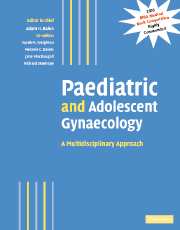Book contents
- Frontmatter
- Contents
- Contributors
- Preface
- Part I Normal development
- Part II Management of developmental abnormalities of the genital tract
- Part III Management of specific disorders
- 18 Disorders of growth and puberty
- 19 Turner's syndrome
- 20 Androgen insensitivity syndromes
- 21 Rokitansky syndrome and other Müllerian anomalies
- 22 The XY female
- 23 The gynaecology of the major genitourinary anomalies
- 24 Congenital adrenal hyperplasia
- 25 Long-term sequelae of genital surgery
- 26 Amenorrhoea
- 27 The polycystic ovary syndrome and adolescent women
- 28 Menstrual disorders in adolescent girls
- 29 Pelvic pain, ovarian cysts and endometriosis in adolescent girls
- 30 Premature ovarian failure and ovarian ageing
- 31 Gynaecological cancers in childhood
- 32 Late reproductive sequelae of treatment for childhood cancer
- 33 Preservation of fertility before cancer therapy
- 34 The management of infertility with surrogacy and egg donation
- 35 Dermatological conditions of the female genitalia
- 36 Vaginal discharge
- 37 Psychological gender development in individuals born with ambiguous genitalia
- 38 Eating disorders in adolescence
- 39 Nutritional amenorrhoea: long-term sequelae
- 40 How to set up a service: how to teach and train
- Index
- Plate section
- References
21 - Rokitansky syndrome and other Müllerian anomalies
from Part III - Management of specific disorders
Published online by Cambridge University Press: 04 May 2010
- Frontmatter
- Contents
- Contributors
- Preface
- Part I Normal development
- Part II Management of developmental abnormalities of the genital tract
- Part III Management of specific disorders
- 18 Disorders of growth and puberty
- 19 Turner's syndrome
- 20 Androgen insensitivity syndromes
- 21 Rokitansky syndrome and other Müllerian anomalies
- 22 The XY female
- 23 The gynaecology of the major genitourinary anomalies
- 24 Congenital adrenal hyperplasia
- 25 Long-term sequelae of genital surgery
- 26 Amenorrhoea
- 27 The polycystic ovary syndrome and adolescent women
- 28 Menstrual disorders in adolescent girls
- 29 Pelvic pain, ovarian cysts and endometriosis in adolescent girls
- 30 Premature ovarian failure and ovarian ageing
- 31 Gynaecological cancers in childhood
- 32 Late reproductive sequelae of treatment for childhood cancer
- 33 Preservation of fertility before cancer therapy
- 34 The management of infertility with surrogacy and egg donation
- 35 Dermatological conditions of the female genitalia
- 36 Vaginal discharge
- 37 Psychological gender development in individuals born with ambiguous genitalia
- 38 Eating disorders in adolescence
- 39 Nutritional amenorrhoea: long-term sequelae
- 40 How to set up a service: how to teach and train
- Index
- Plate section
- References
Summary
Introduction
This chapter relates to a wide range of Müllerian anomalies, which divide themselves into obstructive and nonobstructive disorders and aplasias. Müllerian aplasia is also known as the Mayer—Rokitansky—Küster—Hauser syndrome (MRKH or simply Rokitansky syndrome). This was first given its eponym by Hauser and Schreiner in 1961 (based on a review of the postmortem reports of Mayer (1829), Rokitansky (1838) and Küster (1910)).
Aetiology
The development of the normal female reproductive tract requires differentiation and development of the Müllerian ducts. These arise within the embryo only if there is an absence of the Y chromosome. During embryological development, both Müllerian and Wolffian ducts are present and remain so until the developing fetus is around 150–200 mm in length. In the presence of a gonad that has differentiated into a testis, the Sertoli cells produce anti-Müllerian hormone, which causes regression of the Müllerian ducts and persistence of the Wolffian ducts. The absence of a Y chromosome and, therefore, the failure of testicular development means that the Müllerian ducts persist; the failure to produce testosterone means that the Wolffian ducts regress. The genetic control of this development is poorly understood, but the association with other abnormalities and some familial developments suggest that there are genetic factors that determine abnormalities of this development and only rarely has it been suggested that these abnormalities are environmental. At a molecular level, the information is again poor, although certain developmental genes, e.g. HOXA 13, seem to be involved in some way.
- Type
- Chapter
- Information
- Paediatric and Adolescent GynaecologyA Multidisciplinary Approach, pp. 267 - 274Publisher: Cambridge University PressPrint publication year: 2004
References
- 3
- Cited by



